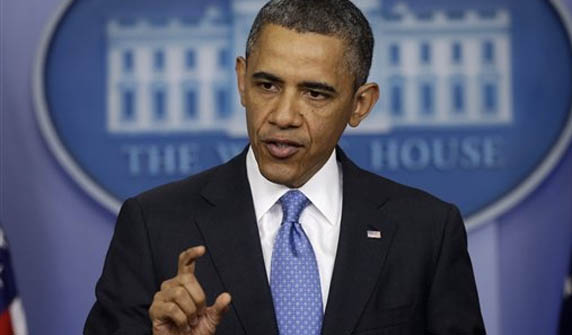
President Barack Obama gets hammered with questions about Benghazi and the Internal Revenue Service controversies May 13 during a news conference that was supposed to be about U.S.-British relations. Photo: AP
Circling the Wagons at 1600 Pennsylvania Avenue
The recent history of second term U.S. presidents indicates trouble will come at some point. You just don’t expect it to come three at a time with roots both foreign and domestic. But for the moment that is where the Obama administration finds itself.
All of sudden last November’s easy re-election victory over Republican Mitt Romney seems like a galaxy far, far away. And that soaring rhetoric from the second Obama inaugural about all of the hoped-for accomplishments now sounds a bit off key. Second term presidents often find that their relevance begins to wane after the second congressional midterm election, in the final two years of their presidency. But in some ways it feels like it’s already waning with this president.
The IRS and Ghosts of Nixon
President Obama was rightfully indignant about attempts by America’s taxation authority, the Internal Revenue Service, to target Tea Party and other conservative groups for special scrutiny. The president told a news conference this week that operating the IRS in “anything less than a neutral and non-partisan way” would be “outrageous,” and he quickly added that he wouldn’t tolerate it. He also said he wasn’t aware of it until recently and there is no suggestion the White House was behind the idea.
Allegations of abuse by the IRS conjures up memories of the administration of President Richard Nixon and his efforts to intimidate and punish political opponents, sometimes by threating IRS audits as political payback. Nixon is the only president who ever resigned the presidency and the last thing any president wants, especially a Democrat, is to be lumped into the same category with the man who left the office in disgrace back in 1974. In fact for both parties, using the IRS as a political tool is one of those accepted “no-no’s” that would invite certain political peril.

President Richard Nixon tells a news conference in March of 1973 his administration would not cooperate with an investigation into the Watergate scandal. Photo: AP
The IRS has already apologized for scrutinizing the tax-exempt status of some of the conservative groups. But this has already set off a firestorm over on the political right and it’s hard to imagine a dumber political move than to play right into the hands of your harshest critics, the Tea Party groups, by putting them in the position of playing the victims.
This is likely to rekindle some of the Tea Party true believers and get them fired up for the 2014 congressional midterm elections. A pretty neat trick given how distraught and bummed out they were when the president won a second term at the White House last November.
Given the Tea Party influence among Republicans in the House of Representatives, it could also make it even less likely that some of the president’s major domestic goals like immigration reform will have much of a chance getting through the House. The politics of Washington went sour some years ago but this kind of thing just gets everyone on the political right “fired up and ready to go”, to borrow a phrase from the Obama campaign, circa 2008.
Targeting the AP
Add into the mix the revelations that the Justice Department last year secretly obtained two months of telephone records of reporters and editors at the Associated Press, supposedly in connection with an AP story a year ago that focused on a foiled terror plot.

Attorney General Eric Holder leaves a news conference May 14, after being questioned about the Justice Department’s investigation of the Associated Press. Photo: AP
AP officials described the act as a “massive and unprecedented intrusion” into their news gathering operation and are demanding explanations from the Justice Department. The irony here is that it was congressional Republicans who were demanding an investigation into leaks about the Obama administration’s anti-terror efforts that appeared to portray it in a positive light.
Federal prosecutors have been known to request reporter phone records in the past. But the extent of the Justice Department sweep encompassing so many AP staffers and different bureaus is considered unusual.
So now you’ve got civil libertarians on both ends off the political spectrum spitting mad about both the IRS missteps and the apparent fishing expedition targeting the Associated Press. News organizations are usually notified in advance when the government is seeking phone records and very often a negotiation ensues as to what in the end will be turned over. But the fact this was done secretly and covered a two month period has sparked an angry reaction, not just from the AP but from journalist watchdog groups around the country.
Benghazi Won’t Go Away
In his latest news conference, the president was much more forceful in putting up a defense of his administration’s handling of the attacks in Benghazi, Libya, last September 11th. Mr. Obama blasted the back and forth over administration talking points about the attack as a political sideshow being fomented by partisan Republicans.

Christopher Stevens, the U.S. Ambassador to Libya, was killed in an attack on the consulate in Benghazi last September 11, in an incident that is still causing political fallout. Photo: AP
On one hand the story has had some staying power, given that it hasn’t gone away even after congressional hearings featuring former Secretary of State Hillary Clinton. At the same time, some Republicans are coming close to overplaying their hand. For example, Oklahoma Senator Jim Inhofe compared it to Watergate and the Iran-Contra scandal and raised the possibility that the president might be impeached over the incident.
An added temptation for some Republicans is that they can’t seem to resist trying to pin much of the responsibility for the problems at Benghazi on Hillary Clinton. They would like nothing better than to politically knock her down a peg or two well in advance of the 2016 presidential election cycle should she decide to run.
The problem is, even if some Republicans are going overboard on Benghazi, it becomes added into the mix of the IRS flap, plus the new revelations about tapping the AP phones. These budding all-at-once mini-scandals tend to have a greater cumulative impact on the public and can give the impression that the administration has been weakened and is in political trouble.
Obama’s Credibility at Stake
All three of these issues relate to the central concern about the president’s credibility, and that is something that could affect the rest of the administration’s second term. Just a few weeks ago, administration supporters were enthusiastic about the prospects of passing gun control legislation, immigration reform and maybe even getting a long term deficit reduction deal.
Gun control has now been defeated and the prospects for a sweeping deficit deal seem to be fading. Immigration reform remains the best hope as a major accomplishment for the second term. But the worry now is that these three controversies over the IRS, Benghazi and phone monitoring will taint the political waters to the point where compromise on a major piece of legislation becomes untenable. Few would have predicted that a key turning point in this administration’s second term would come so quickly. But it appears to be here.






































